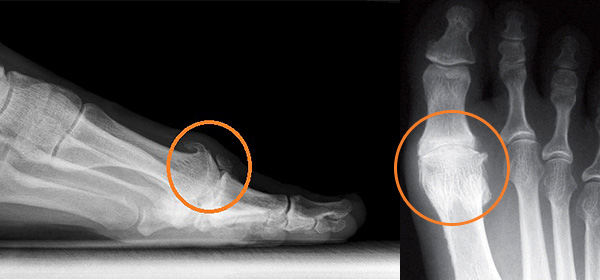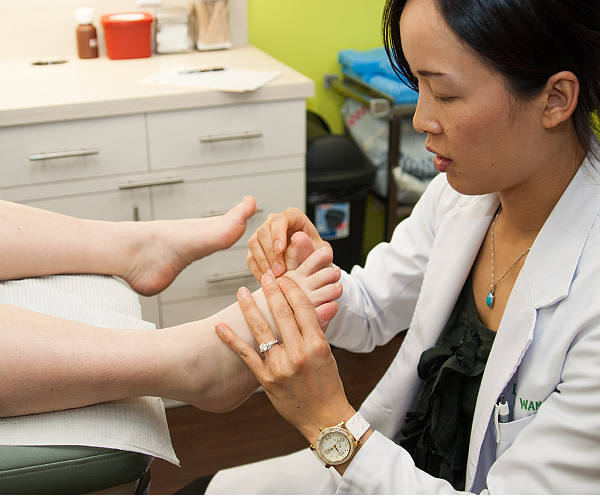Hallux Limitus and Hallux Rigidus are disorders of the joint located at the base of the big toe. It causes pain and stiffness in the big toe, especially during weight bearing and activity. With time, it gets increasingly harder to bend the toe. Hallux refers to the big toe, while limitus means there is limited or decreased joint motion, and rigidus indicates that the toe is rigid and cannot move. Both are actually forms of degenerative arthritis — deterioration of the cartilage within the joint that occurs in the foot and other parts of the body.

Hallux Limitus/Rigidus is caused by arthritic changes occurring at big toe joint, resulting diminished motion and function.
Because hallux rigidus is a progressive condition, the toe’s motion decreases as time goes on. In its earlier stage, motion of the big toe is only somewhat limited — at this point, the condition is called hallux limitus. But as the problem advances, the toe’s mobility or range of motion gradually decreases until it potentially reaches the end stage of rigidus — where the big toe becomes stiff and barely moves, or what is sometimes called a frozen joint. Other problems are also likely to occur as the disorder progresses. Compensation may occur during walking by putting more pressure over the outside of the foot to avoid bending at the big toe joint.
Early Signs and Symptoms:
- Pain and stiffness in the big toe during activity (walking, standing, bending, etc.)
- Pain and stiffness aggravated by cold or damp weather.
- Difficulty with certain activities (running, squatting, kneeling).
- Swelling and inflammation around the joint.
Symptoms in Advanced Arthritis of Big Toe Joint (Hallux Rigidus):
- Pain, even during rest.
- Difficulty wearing shoes because bone spurs (overgrowths) develop around the big toe joint. Wearing high-heeled shoes can be particularly difficult.
- Dull pain in the hip, knee, or lower back due to changes in the way you walk.
- Limping, in severe cases.

Hallux Rigidus is advanced arthritis within the big toe joint in which motion is very limited.
What Causes Hallux Limitus / Rigidus?
Common causes of hallux limitus or rigidus are faulty function (biomechanics) and structural abnormalities of the foot that can lead to osteoarthritis in the big toe joint. This type of arthritis — the kind that results from “wear and tear” — often develops in people who have pre-existing conditions that change the way their foot and big toe functions. For example, those with fallen arches or excessive pronation (rolling in) of the ankles are susceptible to developing hallux rigidus.
In some people, hallux rigidus runs in the family and is a result of inheriting a foot type that is prone to developing this condition. In other cases, it is associated with overuse — especially among people engaged in activities or jobs that increase the stress on the big toe, such as workers who often have to kneel or squat. Hallux rigidus can also result from an injury — even from stubbing your toe or it may be caused by certain inflammatory diseases, such as rheumatoid arthritis or gout. A foot specialist can determine the cause of your hallux rigidus and recommend the best treatment.
Diagnosis of Hallux Limitus / Rigidus
The sooner this condition is diagnosed, the easier it is to treat. Therefore, the best time to see a foot specialist is when you first notice that your big toe feels stiff or hurts when you walk, stand, bend over, or squat. If you wait until bone spurs develop, your condition is likely to be more difficult to manage.

Bone spurs or overgrowths are often associated with arthritis in the big toe joint.
In diagnosing hallux limitus/rigidus, the doctor will examine your feet and manipulate the toe to determine its range of motion. X-rays are usually required to further determine how much arthritis is present as well as to evaluate any bone spurs or other abnormalities that may have formed.

Dr. Alice Wang evaluates a patient with hallux limitus.
Treatment — Non-Surgical Approaches
If your condition is caught early enough, it is more likely to respond to less aggressive treatment. In fact, in many cases, early treatment may prevent or postpone the need for surgery in the future. That’s why it is important to see a foot specialist when you first begin to notice symptoms.
Treatment for mild or moderate cases of hallux limitus may include one or more of these strategies:
Shoe Modifications.
Shoes that have a large toe box should be worn, because they put less pressure on your toe. Stiff or rocker-bottom soles may also be recommended. Most likely, you’ll have to stop wearing high heels.
Custom Orthotics.
Custom orthotics are prescription medical devices worn in your shoes and they are made from molds of your feet. The goal of such devices is to realign joints in the foot and redistribute pressure from body weight evenly, thus improve the function of your big toe joint in early stages of arthritis (Hallux Limitus). Orthotics are also used to prevent further progression of joint degeneration through control of biomechanical function of the lower extremities.
Medications.
Non-steroidal anti-inflammatory drugs (NSAIDs) may be prescribed to help reduce pain and inflammation. Supplements such as glucosamine-chondroitin sulfate and some vitamins and minerals may also be helpful.
Injection Therapy.
Injections of corticosteroids in small amounts are sometimes given in the affected toe to help reduce the inflammation and pain. Often, this can be used to delay the need for surgery.
Physical Therapy.
Ultrasound therapy or other physical therapy modalities may be undertaken to provide temporary relief.
When is Surgery Needed?
In some cases, despite attempts of conservative methods, surgery is the only way to eliminate or reduce pain. There are several types of surgery that can be undertaken to treat hallux limitus and hallux rigidus with great long term outcome. Our doctor has extensive surgical training and experience with treating this condition. See Hallux Limitus / Rigidus Surgery for more information.
If you suffer from pain in your big toe joint, contact our office for a consultation with our foot specialist today.

